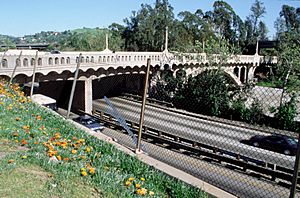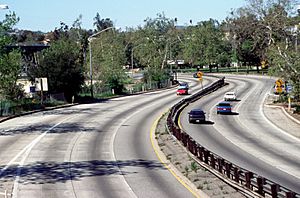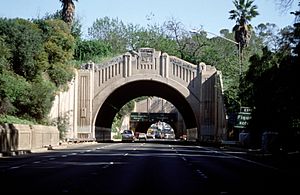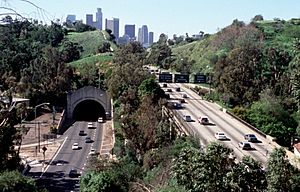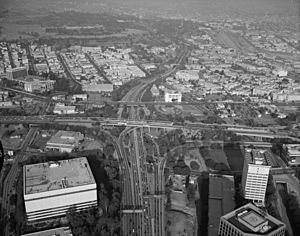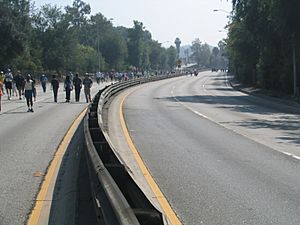Arroyo Seco Parkway facts for kids
Quick facts for kids
Arroyo Seco Parkway |
|
|---|---|
| Pasadena Freeway Part of Historic US Route 66 |
|
| Lua error in Module:Infobox_road/map at line 15: attempt to index field 'wikibase' (a nil value).
Arroyo Seco Parkway highlighted in red
|
|
| Route information | |
| Maintained by Caltrans | |
| Length | 8.162 mi (13.135 km) |
| History | Opened in 1940; renamed in 1954; name reverted in 2010 |
| Tourist routes |
|
| Restrictions | No trucks over 3 tons (including buses, unless authorized by the California Public Utilities Commission) |
| Major junctions | |
| South end | |
| North end | Glenarm Street in Pasadena |
| Location | |
| Counties: | Los Angeles |
| Highway system | |
| State highways in California(list • pre-1964) History • Unconstructed • Deleted • Freeway • Scenic |
|
|
Arroyo Seco Parkway Historic District
|
|
| NRHP reference No. | 10001198 |
| Added to NRHP | February 17, 2011 |
The Arroyo Seco Parkway, also known as the Pasadena Freeway, is a very important road in the United States. It was the first "freeway" ever built in the country! It connects the big city of Los Angeles with Pasadena. This road runs along the Arroyo Seco, which is a river that flows mostly during the rainy season.
The parkway is special because it was mostly opened in 1940. It shows how roads changed from older "parkways" to the modern freeways we use today. When it was built, it was very modern. But now, it seems a bit narrow and old-fashioned compared to newer freeways. In 1953, the southern end of the parkway was extended. It then connected to the Four Level Interchange in downtown Los Angeles. This connected it to the rest of the freeway system.
The road looks much like it did when it first opened. The plants in the middle of the road (called the median) have been replaced. Now there are steel or concrete barriers for safety. Today, the road is called State Route 110. It used to be part of the famous U.S. Route 66. From 1954 to 2010, its official name was the Pasadena Freeway. But in 2010, the California Department of Transportation (Caltrans) changed it back to Arroyo Seco Parkway. This was done to make it more scenic and safer.
All the bridges built when the parkway was made are still there. Also, four older bridges that crossed the Arroyo Seco before the 1930s remain. The Arroyo Seco Parkway is recognized as a State Scenic Highway. It is also a National Historic Civil Engineering Landmark and a National Scenic Byway. In 2011, it was added to the National Register of Historic Places.
Contents
Exploring the Arroyo Seco Parkway
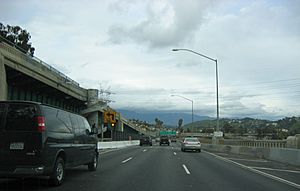
The Arroyo Seco Parkway has six lanes. It is part of State Route 110. The parkway starts at the Four Level Interchange. This is a large, stacked interchange in downtown Los Angeles. It connects the Pasadena (SR 110 north), Harbor (SR 110 south), Hollywood (US 101 north), and Santa Ana (US 101 south) Freeways.
The first exit is for Figueroa Street. Then the freeway meets Hill Street. This exit helps drivers get to Dodger Stadium. After Hill Street, the road gets wider. It has four lanes going north and five lanes going south. This part of the road goes through the hilly Elysian Park.
Northbound cars go through four Figueroa Street Tunnels. Southbound cars go through a "cut" in the hills and over bridges. There's an exit for Solano Avenue and Amador Street between the first and second tunnels. After the last tunnel, there's an exit for Riverside Drive. This also connects to the northbound Golden State Freeway (I-5).
Right after these ramps, the parkway crosses two bridges over the Los Angeles River. This is near where the Arroyo Seco river joins the Los Angeles River. The parkway also crosses over Avenue 19 and San Fernando Road. An onramp from San Fernando Road joins SR 110 northbound. The parkway then goes under I-5. Another exit connects to the northern part of Figueroa Street.
This is where the original 1940 freeway begins. It was mostly built along the west side of the Arroyo Seco. The southbound lanes curve from their 1943 path over the Los Angeles River. They then join the original road next to the northbound lanes.
The original freeway passes under an extension of the 1925 Avenue 26 Bridge. This is one of four bridges that were there before the parkway was built. There are exits and entrances at Avenue 26. These ramps also connect to both directions of I-5. SR 110 continues northeast along the Arroyo Seco. It passes under the L Line light rail and Pasadena Avenue.
Next is the exit for Avenue 43. This is one of many "folded diamond" exits. These exits have very tight curves. The next exit, at Avenue 52, is a normal diamond interchange. Soon after is Via Marisol. Here, the northbound side has standard ramps. But on the southbound side, Avenue 57 acts as a folded diamond connection.
The 1926 Avenue 60 Bridge is another original bridge. It is also a folded diamond interchange. Southbound cars use Shults Street to connect. The 1895 Santa Fe Arroyo Seco Railroad Bridge (now for the L Line) is just past that. After that, there's a "half diamond" exit at Marmion Way/Avenue 64. This exit only allows access towards Los Angeles.
The freeway then goes under the 1912 York Boulevard Bridge. This is another pre-parkway bridge. Southbound connections can be made via Salonica Street. The Arroyo Seco river curves north towards Pasadena. But the Arroyo Seco Parkway curves east. It crosses the stream into South Pasadena. A northbound exit on the Los Angeles side curves left under the bridge. It leads to Bridewell Street, which is a side road next to the parkway.
As you enter South Pasadena, you can see a "City of South Pasadena" sign. It was built in the late 1930s. It uses stones from the creek bed embedded in a hillside. This last part of the parkway goes east in a cut next to Grevelia Street. There's a full diamond exit at Orange Grove Avenue. There's also a half diamond exit at Fair Oaks Avenue. Between these two streets, the parkway goes under the L Line for the third and final time.
After Fair Oaks Avenue, SR 110 curves north. It goes around the east side of Raymond Hill. Then it enters Pasadena. The last exit is a southbound exit to State Street. This exit gives access to Fair Oaks Avenue. The freeway, and state maintenance, ends at Glenarm Street. But the Arroyo Parkway continues north as a city road. It goes to Colorado Boulevard (which was part of historic U.S. Route 66). It continues beyond to Holly Street, near the Memorial Park L Line station.
How Many Cars Use the Parkway?
CalTrans is the California Department of Transportation. In 2016, they counted how many cars used the Arroyo Seco Parkway each day.
- Near Orange Grove Blvd, about 78,000 car trips happened daily.
- Near Avenue 64, about 100,000 car trips happened daily.
- Near Avenue 43, about 123,000 car trips happened daily.
History of the Parkway
Planning the Road
The Arroyo Seco means "dry gulch" or "streambed" in Spanish. It's a stream that carries rainwater from the San Gabriel Mountains. It flows south through Pasadena and into the Los Angeles River near downtown Los Angeles. When it was dry, it was a faster way for wagons to travel between Los Angeles and Pasadena.
The first plan for a road through the Arroyo was in 1895. In 1897, two more ideas came up. One was for a scenic parkway. The other was for a special path for bicycles. This bike path was partly built and opened in 1900. It was an elevated wooden bikeway. But the "bicycle craze" ended, and electric trains already connected Pasadena to Los Angeles. So, the bike path was taken down.
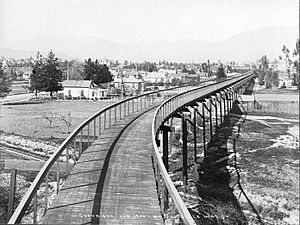
As cars became popular, most plans for the Arroyo Seco included a road. Some people wanted it to be a beautiful parkway. Others, especially the Automobile Club of Southern California, wanted a fast road for commuters. By the mid-1930s, the idea of a recreational parkway was less important. The main goal became building a road for many daily commuters.
There were many debates about where the parkway should go. In the late 1920s, Los Angeles bought land for the road. Work began in the early 1930s. But residents worried about the road affecting their neighborhoods. Work stopped for a while to sort out the details. In 1935, a bill was passed to make the route part of the state highway system. This created a new Route 205.
Building the Parkway
To connect the parkway to downtown Los Angeles, the city improved Figueroa Street. It became a four-lane road to the Los Angeles River. This helped drivers avoid busy bridges. A big part of this project was in Elysian Park. Four Art Deco tunnels were built through the hills. The first three opened in 1931, and the fourth in 1936. This completed the extension of Figueroa Street.
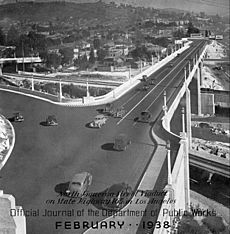
The Arroyo Seco Parkway was the first road in California built under a 1939 law. This law allowed access to the road to be limited to specific points. This is what makes a "freeway." The highway was designed with two 11- to 12-foot lanes and a 10-foot shoulder in each direction. The wider inside lanes were paved in black asphalt. The outside lanes were paved in white concrete. This was meant to encourage drivers to stay in their lanes. Later, the shoulders were turned into extra lanes for more traffic. About 50 "safety bays" were added in 1949 and 1950. These were places where broken-down cars could pull over safely.
Before the parkway was built, many roads and train lines crossed the Arroyo Seco on bridges. New bridges were built for the parkway. Only four of the old bridges were kept, like the York Boulevard Bridge. In South Pasadena, seven streets and two railroad lines were carried over the parkway on bridges. This helped keep the communities connected.
Construction on the Arroyo Seco Parkway began on March 22, 1938. It generally moved from Pasadena southwest. The first part, less than a mile long, opened on December 10, 1938. A longer section, about 3.7 miles, opened on July 20, 1940. The rest of the parkway in Los Angeles opened on December 31, 1940. This was just in time for the Tournament of Roses Parade and Rose Bowl on New Year's Day. The final cost was $5.75 million. This was very low for a freeway project because the land was good for building.
The state started improving the four-lane North Figueroa Street extension in October 1940. This was even before the parkway was finished. The intersection with Riverside Drive was already very busy. The parkway's six lanes narrowing to four surface street lanes would cause more problems. The two-way Figueroa Street Tunnels were changed for four lanes of northbound traffic. A higher southbound road was built to the west. This extension was designed like a freeway, not a parkway. It needed to be built quickly for existing traffic. This extension opened on December 30, 1943.
While the Arroyo Seco Parkway was being built, other freeways were also taking shape. The Cahuenga Pass Freeway opened in 1940. Over the next 20 years, many other freeways were built. The most important part of this system was the Four Level Interchange. This was the first "stack interchange" in the world. It was finished in 1949. But it wasn't fully used until September 22, 1953. That's when the short extension of the Arroyo Seco Parkway to the interchange opened. The public often called it the "Arroyo Seco Freeway." But it was officially a "Parkway" until November 16, 1954. That's when the California Highway Commission officially changed its name to the Pasadena Freeway.
In June 2010, the state started changing signs. They removed the Pasadena Freeway name and brought back the Arroyo Seco Parkway name. Signs that said "freeway" were changed to "parkway" or "Pkwy."
After Construction
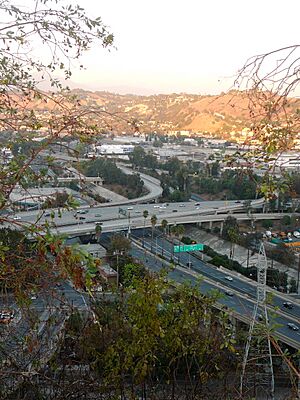
Even though traffic has grown a lot, the original road north of the Los Angeles River is mostly the same as it was in 1940. Trucks and buses were banned in 1943. This has helped keep the freeway in good shape and safe. But the design is old. It has tight "right-in/right-out" exits. These exits have a recommended speed of 5 mph. There are also stop signs on the entrance ramps. There are no special lanes for speeding up or slowing down. The curves are banked for higher speeds, but they are half the modern standard.
The only major changes to the freeway north of the river include the Golden State Freeway (I-5) interchange. This was finished in 1962. Also, the original southbound exit to Fair Oaks Avenue was closed because it was dangerous. The shrubs in the 4-foot middle section were replaced with steel and then concrete barriers. Los Angeles paid to rebuild the interchange at Hill Street in the early 1960s. This was to serve the new Dodger Stadium.
When the Arroyo Seco Parkway opened, it was the first freeway in the Western United States. It became a new part of U.S. Route 66. The southern extension to downtown Los Angeles also carried other routes. In 1981, its number was changed to SR 110.
The Arroyo Seco Parkway is still the most direct way between downtown Los Angeles and Pasadena. The Gold Line light rail, opened in 2003, offers another way for people to travel. The state legislature called the original section a "California Historic Parkway" in 1993. This is a special title for freeways built before 1945. The American Society of Civil Engineers named it a National Historic Civil Engineering Landmark in 1999. It became a National Scenic Byway in 2002. In 2011, it was added to the National Register of Historic Places. In 2003, the freeway was closed to cars for a day for an event called "ArroyoFest." People could walk and bike on the freeway.
Parkway Exits
The entire route is in Los Angeles County.
| Location | mi | km | Exit | Destinations | Notes |
|---|---|---|---|---|---|
| Los Angeles | 23.76 | 38.24 | – | Continuation beyond US 101 | |
| 24A | Four Level Interchange; exit 3B on US 101 | ||||
| 24.49 | 39.41 | 24B | Sunset Boulevard | Southbound exit and northbound entrance | |
| 24.66 | 39.69 | 24C | Hill Street – Chinatown, Civic Center | No southbound entrance; signed as exit 24B northbound; left exit southbound | |
| 24D | Stadium Way – Dodger Stadium | Signed as exit 24B northbound | |||
| 25.02 | 40.27 | 25 | Solano Avenue / Academy Road | ||
| Figueroa Street Tunnels (northbound) | |||||
| 25.68 | 41.33 | 26A | Northbound exit and southbound entrance; exit 137B on I-5 | ||
| 25.71 | 41.38 | 26B | Figueroa Street | Northbound left exit and southbound entrance; former SR 159 | |
| 25.84 | 41.59 | 26A | Avenue 26 | Southbound exit and northbound entrance; former SR 163 | |
| 26B | Southbound exit and northbound entrance; exit 137 on I-5 | ||||
| 27.05 | 43.53 | 27 | Avenue 43 | ||
| 27.98 | 45.03 | 28A | Avenue 52 | ||
| 28.31 | 45.56 | 28B | Via Marisol | Formerly Hermon Avenue | |
| 28.69 | 46.17 | 29 | Avenue 60 | ||
| 29.43 | 47.36 | 30A | Marmion Way / Avenue 64 | Northbound exit and southbound entrance | |
| 30 | York Boulevard | Southbound exit and entrance | |||
| 30.01 | 48.30 | 30B | Bridewell Street | Northbound exit only | |
| South Pasadena | 30.52 | 49.12 | 31A | Orange Grove Avenue | |
| 31.10 | 50.05 | 31B | Fair Oaks Avenue – South Pasadena | No northbound entrance | |
| Pasadena | 31.84 | 51.24 | Northern terminus of freeway and state maintenance | ||
| 31.91 | 51.35 | – | Glenarm Street | At-grade intersection | |
| 32.47 | 52.26 | – | California Boulevard | At-grade intersection | |
| 33.05 | 53.19 | – | At-grade intersection | ||
| 33.15 | 53.35 | – | Colorado Boulevard | At-grade intersection; former SR 248 | |
| 1.000 mi = 1.609 km; 1.000 km = 0.621 mi | |||||
See also
 In Spanish: Arroyo Seco Parkway para niños
In Spanish: Arroyo Seco Parkway para niños



